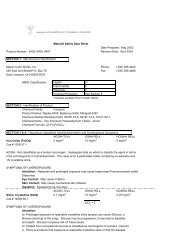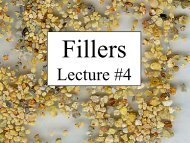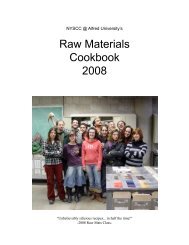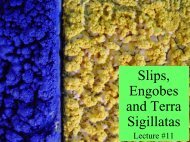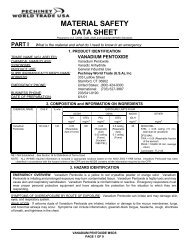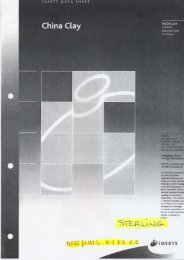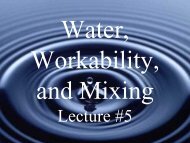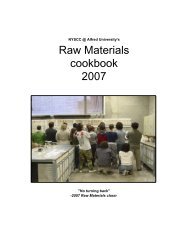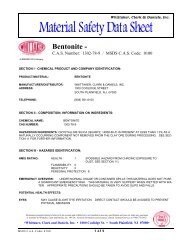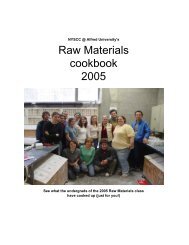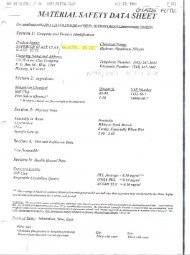Slips and engobes - Alfred's Clay Store
Slips and engobes - Alfred's Clay Store
Slips and engobes - Alfred's Clay Store
You also want an ePaper? Increase the reach of your titles
YUMPU automatically turns print PDFs into web optimized ePapers that Google loves.
<strong>Slips</strong> <strong>and</strong><br />
<strong>engobes</strong><br />
Lecture #11
<strong>Slips</strong> <strong>and</strong> <strong>engobes</strong><br />
• Historically used in Europe to make red clays look like<br />
imported white porcelain<br />
• <strong>Slips</strong> <strong>and</strong> <strong>engobes</strong> are used for many different reasons<br />
– Brighten overlying glazes on darker colored clays<br />
– Create a dense surface over an otherwise porous body<br />
– Allow for a vast pallet of color <strong>and</strong> texture<br />
– Cover up surface imperfections/roughness/even iron spots<br />
– Improve glaze fit without adjusting the glaze or the clay<br />
body (create a buffer layer)<br />
• WYSIWYG<br />
– Don’t run<br />
– Don’t pinhole (during firing)
• Traditionally<br />
– <strong>Slips</strong> are made exclusively of clay<br />
• For wet to leatherhard application<br />
– Engobes always contain fluxes <strong>and</strong> fillers <strong>and</strong><br />
usually contain clay<br />
• Often used for bisque-fired ware<br />
• Usually, though not exclusively, denser than slips<br />
• Today we call both categories “slips”<br />
• <strong>Slips</strong> are distinguished by the state of the<br />
ware to which they are applied <strong>and</strong> by the<br />
extent of vitrification<br />
– I.e. Vitreous or non-vitreous slip<br />
• for wet, leatherhard, green, or bisque application
• C.f . Latin – “sealed earth”<br />
Terra sigillata<br />
– 1 st century B.C. (spread by the Roman empire)<br />
• Historically used to seal a porous clay<br />
– Also used in drain tiles to make them waterproof<br />
• Usually applied to leatherhard-dry clay<br />
• A true slip – Contains just clay<br />
• Made of extremely fine particles (colloidal in size)<br />
– Will not settle or cake over time in the bucket<br />
• Much more opaque than regular slips<br />
– Requires a much thinner coating than regular slips
Terra sigillata<br />
• Dense, silky-smooth, sometimes glossy<br />
– Gloss is temperature dependent based on the clay used<br />
• Generally retained up to C. 04; some can go to C. 2<br />
• Gloss is enhanced by burnishing (re-orients clay particles<br />
parallel to the surface? The jury is deciding on this one)<br />
– Burnishing tools are typically smooth (spoon, river-bed stones);<br />
cloth also works well (t-shirts, cheesecloth, dry-cleaning plastic)<br />
• Historically red clays were used but any plastic (fine) clay<br />
can be used<br />
– White sig. can be prepared from ball clays or kaolins<br />
• Basic Formula<br />
Water 70%<br />
Dry <strong>Clay</strong> 30<br />
Darvan #7 0.1-0.3%<br />
Destroys thixotropy (i.e. helps<br />
non-clays settle)
• Ball mill ingredients<br />
<strong>and</strong> place in jar,<br />
undisturbed for three<br />
days<br />
• After three days,<br />
layers should be well<br />
defined<br />
• Top layer is siphoned<br />
off<br />
• Sig. is then carefully<br />
siphoned off (careful<br />
not to include bottom<br />
layer)<br />
Procedure for<br />
making terra<br />
sigillata
Drawbacks to terra sigillata<br />
• Glazes cannot be layered overtop of terra<br />
sigillata<br />
– Glaze tends to dissolve terra sig. layer<br />
• Terra sig. is too thin to withst<strong>and</strong> glaze fusion<br />
• A lot of clay is wasted in preparing terra<br />
sig.<br />
– 50 lbs. of ball clay yields roughly 2 gallons of<br />
sig.<br />
• This can be somewhat improved by ball milling<br />
• Preparation is somewhat tedious<br />
• Limited firing range
Formulating slips<br />
• A slip can be made by using the clay body itself,<br />
minus any large fillers (i.e.. No grog)<br />
• Advantage<br />
– Compositionally very similar to body<br />
• CTE is almost identical to body<br />
• Drawbacks<br />
– Slip must be applied to very wet clay to avoid cracking<br />
– Slip can’t be lighter in color than the body without<br />
radically changing the sources of clay<br />
• To improve on these limitations <strong>and</strong> to tailor the<br />
slip to our needs, we often include other ingredients
So…<br />
• Slip ingredients usually include:<br />
– <strong>Clay</strong>s<br />
– Fluxes<br />
– Fillers<br />
• A slip may also require:<br />
– Hardeners<br />
– Opacifiers<br />
– Colorants<br />
• These additions depend on the composition of the slip
<strong>Clay</strong>s<br />
• Chosen for their relative color <strong>and</strong> shrinkage<br />
• Light colored clays are necessary for a wide pallet of<br />
colors<br />
– Especially true when developing light colors<br />
• Combinations of kaolin <strong>and</strong> ball clay are normally<br />
used to adjust shrinkage<br />
– More ball clay = more shrinkage<br />
– More kaolin = less shrinkage<br />
– Total clay is usually between 40-80%<br />
• Improve slip’s adherence to the body in dry state<br />
• Help keep slip in suspension<br />
• Improve the brushing qualities of non-plastics
• Amplified by<br />
the presence<br />
of clay<br />
• Can be<br />
exaggerated<br />
by adding salt<br />
Thixotropy<br />
• Retains brushstrokes (can<br />
be good or bad, depending<br />
on your needs)
No salts Salts<br />
Grolleg 48%<br />
Frit 2110 52%<br />
Darvan 811 0.14%<br />
+ Epsom Salts
Fluxes<br />
• Help fuse the slip to the body<br />
• Selection is temperature dependent <strong>and</strong><br />
reflects what we already know for clay<br />
bodies<br />
– High temp-Feldspars/+auxiliary fluxes<br />
– Mid temp-Neph Sy/Talc/Frits<br />
– Low temp-Frits/Talc<br />
• Color response to oxides or stains will be<br />
enhanced or impeded by our choice flux<br />
– Similar to a glaze in this respect
Hi Soda<br />
3110<br />
Hi Calcium/Boron<br />
3124<br />
Hi Calcium/Boron/Alumina<br />
3195<br />
Hi Magnesium<br />
Talc
Fillers<br />
• Silica is the most commonly used<br />
– Promotes hardness (depending on the amount of<br />
vitrification)<br />
– Reduces drying shrinkage<br />
– Promotes whiteness<br />
• Pyrax can also be used (though not as white as<br />
flint)<br />
• Talc (color killer)<br />
• Wollastonite<br />
• Calcined clay (i.e. glomax)<br />
• Filler content usually ranges from 15-30%
Hardeners<br />
• Used to improve hardness of slip after drying (anti<br />
smudging)<br />
– <strong>Slips</strong> high in clay usually don’t require additional hardeners<br />
– Required in low clay-content slips (esp. when ball clay is absent)<br />
• Inorganic<br />
– Borax is soluble<br />
• Recrystallizes when it dries, forming a tough finish<br />
• Can be used up to 5% but other fluxes may need to be decreased (borax is<br />
a boron source so it acts like a flux)<br />
– Bentonite/Vee Gum<br />
• Fine size hardens upon drying (up to 2% Bentonite /up to 1% Vee Gum))<br />
• Organic<br />
– Sugar (dissolved in water first!)<br />
– Gums (CMC, Gum Arabic)<br />
– Spoil with time/can migrate to the top of the container
Opacifiers<br />
• Help ensure whiteness <strong>and</strong> allow for thin application<br />
without loss of opacity<br />
• <strong>Clay</strong> is opaque; recipes low in clay depend on opacifiers<br />
– Not as necessary when dark stains/oxides are used<br />
• Tin Oxide<br />
– Traditional opacifier (600+ years); gives warm whites<br />
– very expensive!<br />
• Zircopax (zirconium silicate)<br />
– Cooler whites (can be compensated with small rutile additions);<br />
more affordable than Tin<br />
• Opacifiers tint colors<br />
– Don’t use if black/dark colors are what you want<br />
– May impede development of saturated colors (I.e. bright yellow,<br />
red etc..)
Colorants<br />
• Can be added as either oxides/carbonates or stains<br />
• Oxides/carbonates<br />
– Cheaper than stains<br />
– Limited pallet / <strong>and</strong> can also produce bubbling (esp. Carbonates)<br />
• Developing strong colors in slips requires larger amounts of<br />
colorants than for glazes<br />
– Glass in glaze provides depth <strong>and</strong> brilliance<br />
– The drier the slip, the more difficult strong color response is (i.e.<br />
vitreous slips are better c<strong>and</strong>idates for strong color than dry, non-<br />
vitreous slips)<br />
• Addition amounts<br />
– Vary with stain/oxide used; lighter colors require more<br />
• I.e. Yellows require 10-15% stain<br />
• Blues require just 3% cobalt carb. (even .25% is noticeable)
Colorants<br />
• Mottled <strong>Slips</strong><br />
– Additions of granulated materials (I.e. rutile, illmenite,<br />
manganese, homemade aggregates)<br />
– Oxides – More mottled (<strong>and</strong> more concentrated)<br />
– Carbonates – Less mottled/more homogenous<br />
• As in glazes, oxides present in slip will push or pull colors<br />
– Some commercial stains will not give the intended color in the<br />
presence of certain oxides, especially zinc<br />
• Mason color chart identifies these (Esp. greens, purples <strong>and</strong> pinks)<br />
• Cautionary note:<br />
– Many metal oxides are not food safe in slips (because slips lack<br />
the glassy structure found in glazes)<br />
• If its not safe in the raw state, chances are it won’t be safe in a fired slip<br />
either
Slip compositions<br />
• Note changes in flux (for temperature<br />
ranges) <strong>and</strong> clay (for application ranges)
Comparing bodies to slips<br />
V.C. HF 4 All purpose white base slip<br />
Cone 9-12<br />
Grolleg<br />
30<br />
EPK<br />
15<br />
XX Sagger<br />
25<br />
Kaolin<br />
Kaolin<br />
Ball <strong>Clay</strong><br />
Nepheline Syenite 15 Soda Spar<br />
Flint 10<br />
Wet to leather hard application<br />
V.C. Off White Throwing Porcelain<br />
Tile #6<br />
Cone 9-10<br />
30<br />
Kaolin<br />
EPK<br />
C&C<br />
15<br />
15<br />
<br />
<br />
Kaolin<br />
Ball <strong>Clay</strong><br />
Kona F-4 20 Soda spar<br />
Flint<br />
10<br />
Pyrax<br />
10<br />
Macaloid +1<br />
• More<br />
similarities<br />
than<br />
differences<br />
between the<br />
two<br />
• Could we use<br />
a slip as a<br />
clay?
Wet vs. Bisque<br />
• Wet application slips<br />
– High clay = creamy quality perfect for painterly<br />
qualities<br />
– <strong>Clay</strong> <strong>and</strong> slip can be carved as one (sgraffito)<br />
– Ideal for slip trailing/thick, textural layering<br />
• Bisque application slips<br />
– Timing is irrelevant (ware can be slipped at leisure)<br />
– Application can be washed off <strong>and</strong> reapplied<br />
indefinitely<br />
– Can be applied over glazed ware<br />
– Work undergoes distortion from drying <strong>and</strong> firing<br />
before slip is applied (great for precise work)
V.C. AT 1 White Vitreous Slip<br />
Cone 6-10<br />
Velvacast<br />
Calcined Kaolin<br />
XX Sagger<br />
Custer Feldspar<br />
Nepheline Syenite<br />
Bisque application slips<br />
10<br />
10<br />
5<br />
25<br />
10<br />
Flint 30<br />
Borax 5<br />
Zircopax 5<br />
C19-1 Dense Bisque Slip<br />
EPK<br />
Cone 04<br />
4<br />
Kaopaque<br />
5<br />
Glowmax<br />
15<br />
Wollastonite<br />
9<br />
Frit 3124<br />
41<br />
Flint 6<br />
Molochite 200 Mesh 20<br />
CMC<br />
+1<br />
• Val’s slip uses calcined clay<br />
• Not creamy compared to<br />
wet application slips<br />
• For thick applications<br />
– Best applied through spraying<br />
– Uses very little raw clay<br />
– Glowmax is calcined<br />
– Molochite is added as a filler
The shrinkage myth<br />
• Many bisque-application slips call for large amounts of<br />
calcined clay<br />
– Myth… During drying, raw clay shrinks / calcined clay<br />
doesn’t so loading up on calcined clay is the answer<br />
– Truth… Water separates particles in both cases…even if you<br />
use just calcined clay, you will get shrinkage (not as much as<br />
with raw clay, but still enough to cause problems)<br />
• Including plastic clay in the recipe increases the strength<br />
of the slip during drying <strong>and</strong> can help it overcome<br />
cracks as the slip is placed in tension during drying<br />
(calcined clay has no strength to overcome this tension)<br />
– Adding too much plastic clay, however, will ultimately<br />
increase shrinkage, tension, <strong>and</strong> cracking…A balance is<br />
required!
Spackle<br />
• For very thick applications on bisqued ware<br />
• Inert<br />
• Lots of calcined materials<br />
– Esp. clays<br />
• Raw clay is used sparingly (10-15%) to suspend<br />
mixture<br />
• Relies heavily on a wide particle size distribution<br />
– Screened material<br />
• Empirical testing (trial <strong>and</strong> error)
• Sudden thickness change from top (thick)<br />
surface to the sides (thin) causes separation
Adding salt to the slip ensures a move even<br />
thickness on both the top <strong>and</strong> sides of a tile<br />
• Without<br />
Epsom<br />
salt<br />
• With<br />
Epsom<br />
salt, the<br />
slip “gels”
¼” thick per<br />
firing without<br />
cracks
Multiple firings,<br />
then cut on a<br />
brick saw<br />
S<strong>and</strong>ed prior<br />
to firing
Spackle<br />
Example<br />
Raw Claw<br />
Cone 04<br />
10<br />
Calcined Kaolin 10<br />
Calcined Ball <strong>Clay</strong> 10<br />
Calcined Fireclay 5<br />
Frit 3110 25<br />
Grog (screened) 30<br />
Wollastonite<br />
10<br />
CMC<br />
+1<br />
Suspension<br />
Low Shrink<br />
Low Shrink<br />
Low Shrink<br />
No shrink<br />
No shrink<br />
• Epsom salt is added to prevent settling<br />
– Added as a saturated solution to the water before adding all<br />
other dry ingredients<br />
– Creates Thixotropy (gelling effect when left undisturbed/coarse<br />
material won’t settle);<br />
– Epsom salt can be added to any slip, provided it contains clay<br />
• Salt affects the raw clay, not the non-plastics<br />
• NOTE: Salt dissolves plaster molds over time!
Using spackle<br />
on bisqued<br />
work
Spackle <strong>and</strong><br />
bisque slip
Vitreous slips<br />
• Halfway between a glaze <strong>and</strong> a slip<br />
– Less clay/shrinkage than regular slip<br />
• 10-20% clay for suspension <strong>and</strong> green strength<br />
• Higher non-plastics<br />
• Higher fluxes<br />
• Can be applied to dry or bisque ware<br />
– More difficult for wet applications because of low clay/low green<br />
shrinkage (can’t keep up with a drying, shrinking clay body as<br />
easily)<br />
• Can be used alone as a functional surface<br />
– Very vitreous / almost glaze-like<br />
• Think of these as slightly underfired opaque glazes<br />
• Can also be used under glazes to influence texture <strong>and</strong><br />
color of glaze
Vitreous vs. Non-Vitreous<br />
V.C. 5 vitreous slip<br />
EPK<br />
Cone 04<br />
20<br />
Frit 3110<br />
20<br />
Nepheline Syenite 20<br />
Whiting<br />
5<br />
High amount of fluxes<br />
Flint 15<br />
Zinc Oxide 20 Opacity/whiteness<br />
Steve’s non-vitreous slip<br />
EPK<br />
Cone 04<br />
9<br />
Om4<br />
37<br />
High plasticity<br />
Frit 3124<br />
11<br />
Lower fluxes, especially<br />
Nepheline Syenite 9<br />
frit<br />
Talc<br />
28<br />
Flint 9<br />
Zircopax +5 Opacity/whiteness<br />
• Both are for dry<br />
to bisque<br />
application<br />
• V.C. 5 vitrifies at<br />
C. 04<br />
– Not much clay<br />
– High amount of<br />
flux<br />
• Steve’s is quite<br />
porous at C. 04<br />
– More clay <strong>and</strong><br />
less active flux<br />
to melt it
Cracking<br />
• Does not occur r<strong>and</strong>omly<br />
• Every slip has a limit as to how thick it<br />
can be applied before cracking occurs<br />
• Cracks begin where there is a sudden<br />
change in thickness<br />
• This can be used effectively to create<br />
designs<br />
– Brushstrokes are never even<br />
• Bristles create ridges <strong>and</strong> valleys (cracks start<br />
in valleys)<br />
• Direction of strokes can be used to one’s<br />
advantage<br />
– I.e. Grids vs. spirals vs. r<strong>and</strong>om patterns<br />
– Scribing into still wet slip will influence<br />
where cracks occur<br />
Slip surface<br />
Crack
Robert Sperry Steve Heinemann
Cracking in wet to leatherhard applications<br />
• Slip cracks, forming little isl<strong>and</strong>s sometimes with<br />
curled-up edges<br />
– Slip is shrinking too much<br />
• Apply slip when clay is wetter<br />
OR…<br />
• Remove some bentonite or substitute ball clay with kaolin<br />
• Slip doesn’t shrink enough - Slip separates in large<br />
sheets from body<br />
– Slip is not shrinking enough<br />
• Apply when clay is drier OR…<br />
• Add finer clays
Solutions to cracking in drying<br />
stage<br />
• Cracking can be minimized by changing<br />
how the slip is applied<br />
– Dipping vs. pouring vs. brushing vs. sponging<br />
vs. spraying<br />
• High water content can lead to cracks<br />
– More water = more shrinkage<br />
• Deflocculating the slip reduces water, <strong>and</strong><br />
by extension, shrinkage<br />
– Adding salt can help control viscosity of a<br />
deflocculated slip (I.e. Stick-up slip)
Crow’s Foot cracking
Cracking due to trapped air<br />
• <strong>Slips</strong> that are thick can trap air during mixing<br />
• Air bubbles don’t allow slip to shrink (tension is formed)<br />
– Bubbles become nuclei for crow’s foot cracking<br />
– Three cracks propagate from a point<br />
• Sometimes the offending bubble is seen at the surface,<br />
sometimes it is below the surface<br />
• Solution… remove bubbles!<br />
– Tapping the container<br />
• Bubbles will rise <strong>and</strong> pop<br />
– Tilt <strong>and</strong> rotate the container to expose bubbles<br />
• Bubbles at the surface will stretch <strong>and</strong> pop<br />
– Increase water content<br />
• Bubbles will rise <strong>and</strong> pop
Cracking after firing<br />
• Slip goes into kiln defect free but comes out<br />
cracked (very annoying)<br />
• Can be due to minute drying cracks (invisible to the<br />
eye); you have exceeded the maximum thickness<br />
for your slip<br />
– Cracks open up during firing<br />
– Common in high zinc slips (zinc shrinks!)<br />
– Solution - Apply a thinner <strong>and</strong> more even coat of slip<br />
• Can be due to large difference in firing shrinkage<br />
between body <strong>and</strong> slip<br />
• Solution - Compare fired shrinkage of body with that of slip (do<br />
shrinkage test bars for both the slip <strong>and</strong> the body)<br />
– If slip shrinks too much - decrease flux<br />
– If slip doesn’t shrink enough - increase flux
Cracking after firing<br />
• Can also be due to a mismatch in CTE between<br />
body <strong>and</strong> slip<br />
• Sharp transitions <strong>and</strong> corners are usually the<br />
first place this happens (the first place to look)<br />
• Usually a case of shivering, where the crack<br />
runs through the body <strong>and</strong> separates the slip<br />
from the surface<br />
• Remedied by increasing the slip’s CTE
Shivering slip
Witness the awesome<br />
destructive force that is…<br />
Shivering
Measuring<br />
slip<br />
thickness<br />
• Easy to do<br />
<strong>and</strong> more<br />
reliable<br />
than<br />
measuring<br />
water<br />
content
Tape<br />
Using a pin<br />
tool as a<br />
thickness<br />
gauge<br />
• Useful for slips<br />
<strong>and</strong> glazes applied<br />
on dry or bisque<br />
ware<br />
• Stab the slip/glaze<br />
before it hardens<br />
• Tape serves as a<br />
visual reference
END



